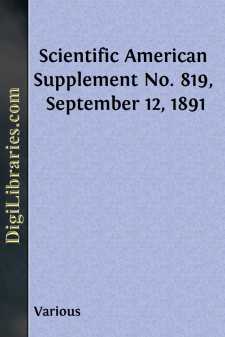Categories
- Antiques & Collectibles 13
- Architecture 36
- Art 48
- Bibles 22
- Biography & Autobiography 813
- Body, Mind & Spirit 142
- Business & Economics 28
- Children's Books 17
- Children's Fiction 14
- Computers 4
- Cooking 94
- Crafts & Hobbies 4
- Drama 346
- Education 46
- Family & Relationships 57
- Fiction 11829
- Games 19
- Gardening 17
- Health & Fitness 34
- History 1377
- House & Home 1
- Humor 147
- Juvenile Fiction 1873
- Juvenile Nonfiction 202
- Language Arts & Disciplines 88
- Law 16
- Literary Collections 686
- Literary Criticism 179
- Mathematics 13
- Medical 41
- Music 40
- Nature 179
- Non-Classifiable 1768
- Performing Arts 7
- Periodicals 1453
- Philosophy 64
- Photography 2
- Poetry 896
- Political Science 203
- Psychology 42
- Reference 154
- Religion 513
- Science 126
- Self-Help 84
- Social Science 81
- Sports & Recreation 34
- Study Aids 3
- Technology & Engineering 59
- Transportation 23
- Travel 463
- True Crime 29
The Atlantic Monthly, Volume 05, No. 28, February, 1860
by: Various
Categories:
Description:
Excerpt
COUNTING AND MEASURING.
Though, from the rapid action of the eye and the mind, grouping and counting by groups appear to be a single operation, yet, as things can be seen in succession only, however rapidly, the counting of things, whether ideal or real, is necessarily one by one. This is the first step of the art. The second step is grouping. The use of grouping is to economize speech in numeration, and writing in notation, by the exercise of the memory. The memorizing of groups is, therefore, a part of the primary education of every individual. Until this art is attained, to a certain extent, it is very convenient to use the fingers as representatives of the individuals of which the groups are composed. This practice led to the general adoption of a group derived from the fingers of the left hand. The adoption of this group was the first distinct step toward mental arithmetic. Previous groupings were for particular numerations; this for numeration in general; being, in fact, the first numeric base,—the quinary. As men advanced in the use of numbers, they adopted a group derived from the fingers of both hands; thus ten became the base of numeration.
Notation, like numeration, began with ones, advanced to fives, then to tens, etc. Roman notation consisted of a series of signs signifying 1, 5, 10, 50, 100, 500, 1000, etc.,—a series evidently the result of counting by the five fingers and the two hands, the numbers signified being the products of continued multiplication by five and by two alternately. The Romans adhered to their mode, nor is it entirely out of use at the present day, being revered for its antiquity, admired for its beauty, and practised for its convenience.
The ancient Greek series corresponded to that of the Romans, though primarily the signs for 50, 500 and 5000 had no place. Ultimately, however, those places were supplied by means of compound signs.
The Greeks abandoned their ancient mode in favor of the alphabetic, which, as it signified by a single letter each number of the arithmetical series from one to nine separately, and also in union by multiplication with the successive powers of the base of numeration, was a decided improvement; yet, as it consisted of signs which by their number were difficult to remember, and by their resemblance easy to mistake, it was far from being perfect.
Doubtless, strenuous efforts were made to remedy these defects, and, apparently as the result of those efforts, the Arabic or Indian mode appeared; which, signifying the powers of the base by position, reduced the number of signs to that of the arithmetical series, beginning with nought and ending with a number of the value of the base less one.
The peculiarity of the Arabic mode, therefore, in comparison with the Greek, the Roman, or the alphabetic, is place value; the value of a combination by either of these being simply equal to the sum of its elements. By that, the value of the successive places, counting from right to left, being equal to the successive powers of the base, beginning with the noughth power, each figure in the combination is multiplied in value by the power of the base proper to its place, and the value of the whole is equal to the sum of those products.
The Arabic mode is justly esteemed one of the happiest results of human intelligence; and though the most complex ever practised, its efficiency, as an arithmetical means, has obtained for it the reputation of great simplicity,—a reputation that extends even to the present base, which, from its intimate and habitual association with the mode, is taken to be a part of the mode itself.
With regard to this impression it may be remarked, that the qualities proper to a mode bear no resemblance to those proper to a base. The qualities of the present mode are well known and well accepted. Those of the present base are accepted with the mode, but those proper to a base remain to be determined. In attempting to ascertain these, it will be necessary to consider the uses of numeration and of notation.
These may be arranged in three divisions,—scientific, mechanical, and commercial. The first is limited, being confined to a few; the second is general, being common to many; the third is universal, being necessary to all. Commercial use, therefore, will govern the present inquiry.
Commerce, being the exchange of property, requires real quantity to be determined, and this in such proportions as are most readily obtained and most frequently required. This can be done only by the adoption of a unit of quantity that is both real and constant, and such multiples and divisions of it as are consistent with the nature of things and the requirements of use: real, because property, being real, can be measured by real measures only; constant, because the determination of quantity requires a standard of comparison that is invariable; conveniently proportioned, because both time and labor are precious. These rules being acted on, the result will be a system of real, constant, and convenient weights, measures, and coins. Consequently, the numeration and notation best suited to commerce will be those which agree best with such a system.
From the earliest periods, special attention has been paid to units of quantity, and, in the ignorance of more constant quantities, the governors of men have offered their own persons as measures; hence the fathom, yard, pace, cubit, foot, span, hand, digit, pound, and pint....












